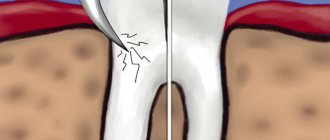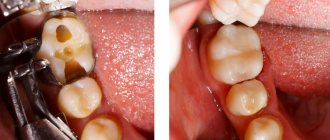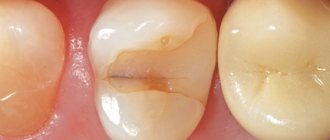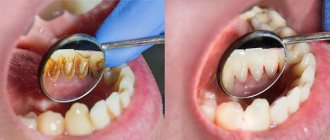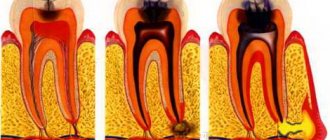Indications
- destruction of the tooth crown by carious processes,
- tooth injuries and chips,
- removal of nerve from tooth roots,
- tooth refilling – removing old dental fillings and replacing them with new ones,
- aesthetic and functional restoration of teeth,
- strengthening the tooth before prosthetics or orthodontic treatment.
Contraindications
- presence of allergies to filling materials,
- the crown of a tooth is destroyed by more than half - in this case there is no point in installing a filling, since its service life will be extremely short due to the thin walls and the impossibility of attaching to the tooth.
Why do you need dental filling?
The first experiments with the installation of fillings were carried out before our era. Holes in the teeth were filled with resin and various mixtures. However, the archaic technique of filling teeth brought almost no positive results. Fortunately, today everything has changed dramatically. Modern fillings are successfully used to perform a variety of tasks, in particular for:
- functional filling
- aesthetic dental filling
- filling root canals
- temporary sealing of a damaged tooth
Types of dental fillings
Classic filling of carious teeth involves the installation of a dental filling without depulpation of the root canals. This technique is used for minor mechanical and carious damage to the tooth (superficial and medium caries) and is carried out in several stages.
When the dental pulp is damaged, in most cases it is necessary to fill the root canals of the teeth. In the case of milk and young molars, there are methods for preserving the functionality of the root - a biological method of treatment using calcium-containing preparations (tooth filling with calcium) or partial amputation of the pulp. This allows you to maintain the blood supply to the tooth and its vitality, which is especially important when it is in the development stage.
Depulpation involves removing the tooth root, cleaning and developing the canals with special instruments and filling them with artificial materials in order to eliminate the risk of developing inflammatory processes. There are various methods of root canal treatment. There is no absolutely ideal method, so the doctor focuses on a specific clinical case.
Types of fillings by service life
Depending on the period during which the fillings are in the tooth cavity, they are divided into two types - temporary and permanent. They differ from each other in the material from which they are made, and also have different appearance.
Temporary
Temporary tooth fillings are used when treatment is carried out in two stages. At the first of them, the doctor cleans the cavity from caries. Next, it is necessary to place special medications into the tooth that disinfect the tissues or promote the death of the dental nerve. This approach is needed in case of deep caries damage or the presence of its complications, for example, periodontitis.
Temporary fillings are also needed if additional time is needed to make a permanent one. Certain types of fillings are made in a laboratory using impressions that are taken from a cleaned cavity. At the same time, at the first appointment with the doctor, a temporary material is installed, and at the next one he can install a permanent one.
Permanent
Permanent fillings are installed during one-stage treatment of caries. In this case, at the first appointment, the doctor cleans the affected cavity and places a permanent filling in it. This method is suitable if we are talking about superficial or medium caries.
Dental filling methods
All methods of filling teeth are based on the use of various materials, which have their own advantages and disadvantages. Therefore, when choosing a technology, the doctor focuses on the individual characteristics of the structure of the root canals and the patient’s body as a whole.
Filling teeth with gutta-percha
Removal of the nerve of the tooth and filling of the canals, when the cavity is filled with a special paste based on gutta-percha with the addition of various impurities. Despite its simplicity and relatively low cost, this method of filling teeth cannot be called reliable and safe. It is often accompanied by a violation of tightness, the development of inflammation and allergic reactions.
Using a pin
Filling a pulpless tooth with pins is one of the most common techniques in dentistry. There are two types of pins (fillers): gutta-percha and metal. Filling tooth canals with gutta-percha is considered a more reliable and safe method. Even taking into account the presence of polymers, dyes and metal salts, such pins are biocompatible and do not cause allergies. Silver metal structures have good flexibility and can be installed in long and curved channels, however, silver is prone to oxidation, which can lead to inflammation. Titanium posts are better in terms of tissue compatibility, but they are very rigid and require the preparation of a special bed, which makes the tooth walls extremely fragile.
Sealers-sealers
Even gutta-percha pins for filling the root canals of teeth by themselves are not able to provide a reliable result, since they do not have antibacterial properties. To improve the quality of filling, dentists use sealers - sealants that ensure a tight fit of the material to the canal walls. There are natural (based on cement, zinc oxide, etc.), polymer sealers, glass ionomer cements and pastes based on calcium hydroxide.
Teeth filling process
- Initial consultation, taking x-rays.
- Coordination of treatment methods and selection of the type of fillings to be installed.
- Anesthesia before therapeutic intervention (local anesthesia, sedation, in rare cases - general anesthesia).
- Preparation of damaged or caries-affected tooth tissues.
- Grinding and processing the surface of the filling for proper closure.
Filling temporary teeth (baby teeth) follows the same plan, however, in pediatric dentistry, more compatible and safe materials are used.
Filling of anterior teeth
In the case of front teeth, the aesthetic aspect comes to the fore, so the filling material must have the appropriate properties. Although the front teeth receive better hygiene due to their accessibility, they are also susceptible to caries. Installing a filling on the front teeth is considered a more complex procedure: it is necessary not only to give the filling the desired shape, but also to choose the right color. In most cases, filling of anterior teeth is carried out using compomers, as well as light composite fillings, which harden under the influence of ultraviolet radiation. Be that as it may, in case of serious damage, it is impossible to achieve good aesthetics with the help of filling, so you often have to turn to orthopedic solutions.
Filling or tab?
Many patients do not understand the difference between installing fillings and installing inlays. Let me explain. Filling is performed for average caries, if the affected area is not too large. Modern light-polymer products are attached to the walls after completion of therapeutic procedures using a special adhesive composition. Under the rays of a special lamp (hence the name), the semi-liquid substance quickly hardens, so that the filling can be installed in one visit to the doctor. A rich palette of colors allows you to choose the shade that best suits your own base. Inlays, most of which are made of ceramics, perform much broader functions. The elements restored in this way are distinguished by high strength, practicality, and durability. To the question “Which is better: installing a filling or an inlay?” It’s impossible to answer unequivocally; it all depends on specific goals. The decision is made by the doctor, but the tabs have a number of undeniable advantages:
- excellent aesthetics;
- high strength;
- long service life;
- favorable payback;
- no shrinkage;
- fissures are not trying.
ON A NOTE! If you need to install a filling inexpensively and quickly, without thinking about the future, then photopolymer materials are an excellent choice for any patient. However, if the teeth are prone to abrasion and the filling material often needs to be replaced, then inlays are more rational - because they do not require constant expansion of the carious cavity for sanitation and treatment.
Installing a seal on a pin
More recently, it has become common practice in dentistry to install a filling on a post if the tooth is more than 50% destroyed. Thus, the technique made it possible to avoid prosthetics. Filling a tooth with a pin must be preceded by removal of the nerve. Then a special screw is inserted into the root canal and fixed with cement. The procedure is completed by layer-by-layer application of light-polymer composite materials. However, installing a pin does not guarantee reliability and safety. Over time, the cement breaks down, causing microbes to get under the filling, causing the formation of caries. Having chosen modern dentistry to install a filling, you are unlikely to encounter such technology.
If the filling falls out
Proper installation of the seal eliminates the risk of it falling out. However, visitors come to our clinic complaining of similar cases after treatment in other places. Most often they occur due to the low qualifications of the doctor and the use of low-grade materials. Loss of tightness and the appearance of cracks at the filling site can also be caused by saliva getting into the treated area. Sometimes installing a filling is not suitable for a particular case at all: the carious cavity is too large, the plug cannot withstand the chewing load and falls out. The doctor should have chosen a different treatment method. In addition, natural shrinkage must be taken into account. If you install a filling without adjusting for this factor, over time the material will shrink, creating a gap between the wall and the composite, opening the way into the structure for dangerous microbes. But doctors are not always to blame. One of the reasons why problems arise after installing a filling is non-compliance with medical recommendations. What is the patient required to do?
- Conduct a preventive examination at least once every six months. For the first time after treatment, it is better to see a doctor monthly.
- Do not eat or drink for several hours after the filling is installed. You should refrain from smoking and drinking alcohol for 2-3 days.
- Protect the body from colds, hypothermia, overheating. Even ordinary ailments can provoke rejection.
- After installing a permanent filling, you should not eat solid food for a week, allowing the new product to successfully integrate into the oral cavity.
- It is advisable to get rid of bad habits: grinding your teeth, biting your nails. You should not visit the bathhouse or experience heavy physical exertion.
- Despite the practicality of modern products, it is better to exclude foods containing strong dyes from the diet.
Installing a filling on a tooth is a simple and effective way to restore the functional and aesthetic properties of the tooth. However, despite the popularity of the procedure, often even the most basic manipulation causes discomfort and pain in the patient. If you entrust a responsible matter to professionals, this will not happen. It is no coincidence that more and more people are turning to the VivaDent clinic to have a filling installed. We employ highly educated specialists who constantly improve their skills. We spare no time in studying the advanced filling installation techniques used in the world and use the best practices in our practice. We guarantee painless treatment and successful results that will exceed your wildest expectations. Installing a filling in our clinic will allow you to completely restore chewing functions and give you the opportunity to give a radiant smile to others. You can make an appointment at a convenient time by phone or using online chat on the website, where specialists are always happy to answer your questions.
Types of filling materials
| Material type | Varieties | Description |
| Cement | – Zinc phosphate – Silicate – Glass ionomer | Currently, of all types of cement fillings, only glass ionomer fillings are actively used, since they provide good mechanical and chemical bonding with tooth tissues. Zinc-phosphate fillings tend to shrink, so they are almost never used when filling teeth for caries. Silicate materials are considered toxic and also have restrictions in their use. |
| Metal | – Gold – Copper – Silver | They are distinguished by high quality and a very large margin of safety. On the other hand, amalgam fillings shrink over time and are not always airtight, which can lead to the development of secondary caries. Due to low aesthetic indicators, they are used for filling chewing teeth. |
| Composite materials | – Acrylic – Epoxy – Light-curing – Chemical-curing | Composite fillings are obtained by mixing organic and inorganic elements. Due to the noticeable disadvantages of filling teeth with composite materials (rapid wear and toxicity for acrylic ones, fragility for epoxy ones), the first two types of fillings are practically not used. Light-curing composites are considered the best: they quickly harden under the influence of ultraviolet radiation and can be used in any part of the jaw. The procedure is often called light dental filling. |
| Compomer | It is a kind of hybrid of glass ionomer and composite | Very aesthetic and high-quality fillings, which are most often used in the frontal region when restoring teeth after chips. Their only drawback is fragility. |
| Materials for temporary fillings | – Artificial dentin – Soft dentin paste – Cariosan (cement) – Vinoxol (zinc oxide based) | They are often placed during pulpitis to check the reaction of the tooth, as well as after filling root canals until a permanent filling is installed. Temporary fillings are also used when filling a tooth under a crown. |
How much does the procedure cost?
The exact cost of dental filling is usually announced by the doctor at the initial consultation. The price will depend on the filling material used and the amount of work. Filling canals will cost more than simply installing a filling.
| Type of filling | Price |
| Cement filling | From 900 rubles |
| Glass ionomer filling | From 1,500 rubles |
| Filling made from a light-curing composite of the latest generation | From 3,500 rubles |
| Filling made from a chemocurable composite of the latest generation | From 2,500 rubles |
Possible complications
The only trouble when treating uncomplicated caries is the gradual decrease in numbness. During this time, doctors recommend refusing to eat so as not to accidentally bite your tongue and gums.
If the dental intervention was deep, the disturbed tooth may ache for 1-2 days. This is the norm. To alleviate the condition, you can take a pain reliever.
Signs of complications after filling:
- aching pain >3 days;
- low-grade fever;
- intense pain that is not relieved by analgesics.
The cause of the symptoms is the development (progression) of inflammation due to improper installation of a filling, incorrectly selected material, or infection in an open tooth cavity. If signs of inflammation appear, you should contact your doctor.

